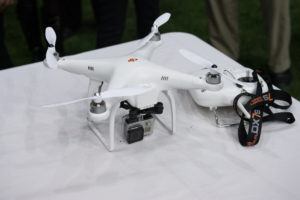 Introduction:
Introduction:
All drone flights on or above University owned or operated property must comply with current federal, state, and local laws, Federal Aviation Administration (“FAA”) regulations, policies, and University guidelines. On December 28, 2020 the FAA announced new rules for UAS or drones that will require Remote Identification and, in certain circumstances, allow flight over people and at night. Brief descriptions of the new requirements are included where applicable, for complete details, please visit the FAA UAS website.
The University will only approve drone flights on or above University property for University-related business. Recreational use of drones is not permitted on or above University owned or operated property. The Office of Institutional Risk Management provides guidance to the University community on the use of drones for University-related business. The guidelines and approvals required for drone flights on campus depend on the purpose of the flight and category of operator.
General Requirements:
- Recreational flights on or above University property are prohibited.
- All flight requests will be made through The Office of Institutional Risk Management, and reviewed for approval prior to the flight.
- Requests should be submitted two weeks in advance of anticipated flight.
- All flight requests will include:
- Rationale / purpose for the flight
- A flight plan including launch location, time of flight, path of flight, landing location, landing time, whether the flight is over people.
- Documentation of registration of the UAS with the FAA
- Certification of compliance with FAA requirements for night flights, if applicable.
- Certification of compliance with Remote ID requirements (beginning 9/17/23).
- Documentation of insurance (third party vendor flights only)
- Approved flights require:
- The presence of a Department of Public Safety Law Enforcement or Fire and Life Safety officer present for the duration. Costs associated with such presence will be borne by the user or user’s department.
- DPS will notify the building coordinators for each building impacted by the potential flight.
- Verification of notification to SUNY Upstate Medical University’s helipad manager
- Adherence to all FAA regulations associated with UAS
- New FAA rules regarding flying over people took effect on 3/17/21. You will need to indicate whether you intend to fly over people and if so, in which category your UAS falls. The ability to fly over people depends on the level of risk to those on the ground and is presented in four categories:
- Category 1: permits flight over people small UAS weighting .55 pounds or less, including all attachments with no exposed rotating parts. Compliance with Remote ID is required for sustained flights over open air assemblies.
- Category 2: applies to UAS weighing more than .55 pounds without a part 21 airworthiness certificate with no exposed rotating parts. Pilot must be able to demonstrate that injuries to a human being are within the rule’s limitations should an impact take place. Compliance with Remote ID is required for sustained flights over open air assemblies.
- Category 3: applies stricter safety standards than category 2, UAS must not contain any exposed rotating parts. Compliance with Remote ID is required for sustained flights over open air assemblies and all those in the assembly site must be notified than a UAS may fly over them.
- Category 4: any UAS with a part 21 airworthiness certificate may operate over people so long as there are no limitations in the flight manual. Compliance with Remote ID is required for sustained flights over open air assemblies.
- New rules regarding flying at night took effect on 3/17/21. If you intend to fly at night, you will need to certify that your UAS meets all FAA requirements for night flights. Night operations are allowed so long as the remote pilot in command has completed an updated initial knowledge test or online recurrent training and the UAS has lighted anti-collision lighting that is visible for at least three statute miles and a flash rate sufficient to avoid a collision
- Remote ID is the ability of the drone to provide identification and location information while in flight. Beginning September 17, 2023 all pilots who are required to register their drone with the FAA will be need to meet the remote ID requirements. There are three ways: operate a standard remote ID drone with built in broadcasting capability, operate a drone with a remote ID broadcast module installed on it, operate a drone without remote ID only in an FAA recognized identification area (FRIA). Beginning 9/17/23 you will be required to certify that your UAS meets the Remote ID requirements for any flights on or above University owned property.
- New FAA rules regarding flying over people took effect on 3/17/21. You will need to indicate whether you intend to fly over people and if so, in which category your UAS falls. The ability to fly over people depends on the level of risk to those on the ground and is presented in four categories:
- The presence of a Department of Public Safety Law Enforcement or Fire and Life Safety officer present for the duration. Costs associated with such presence will be borne by the user or user’s department.
